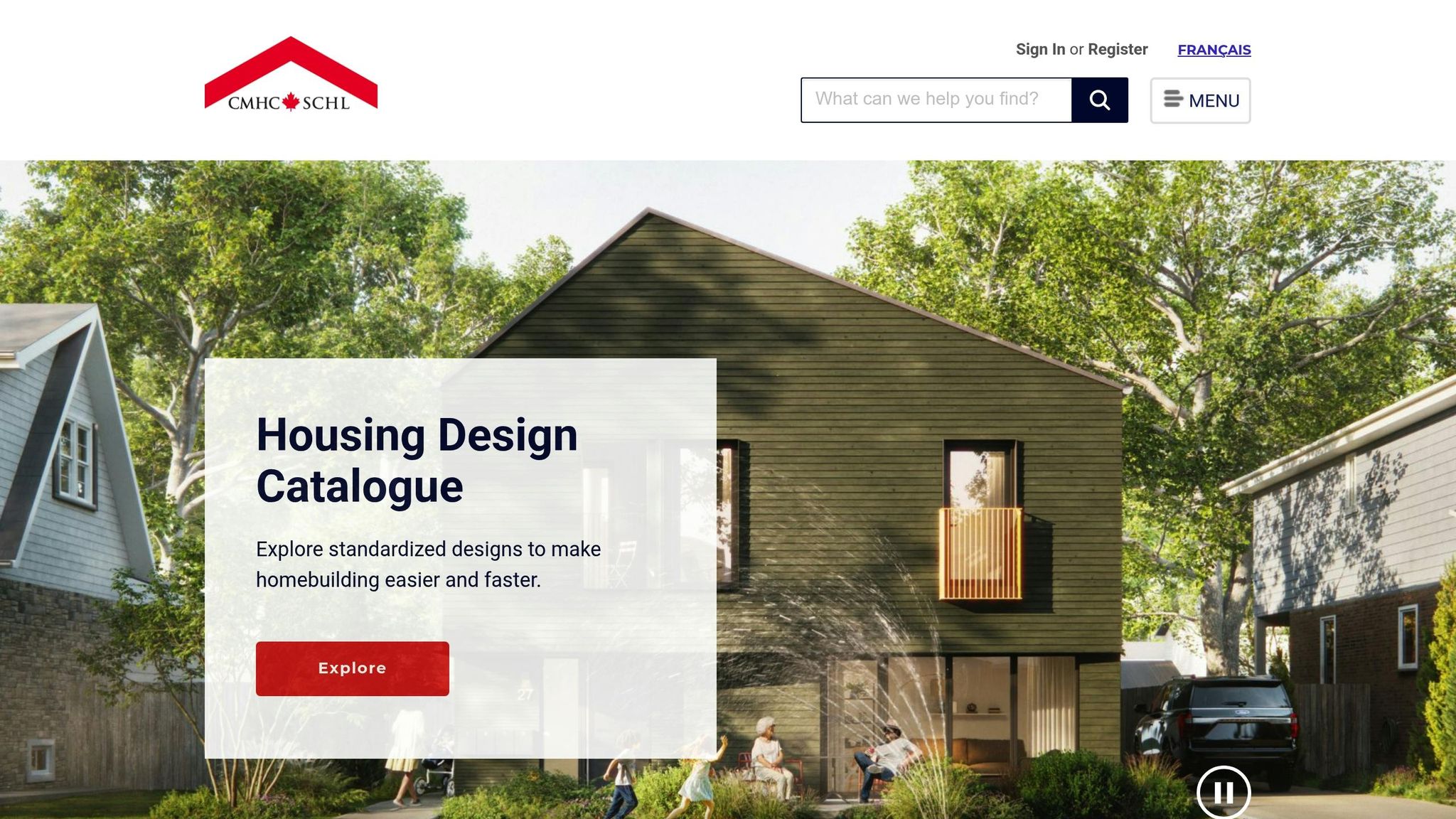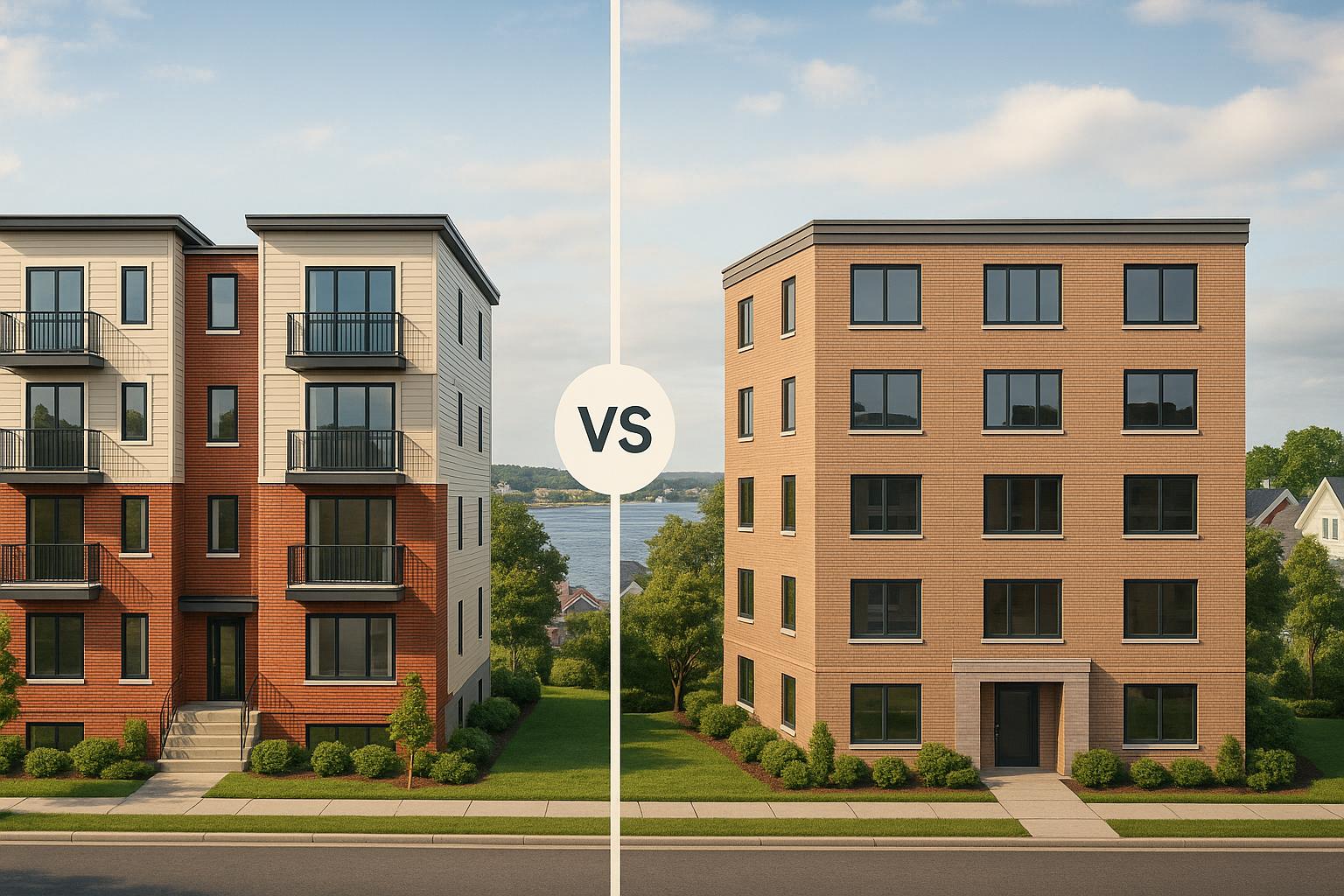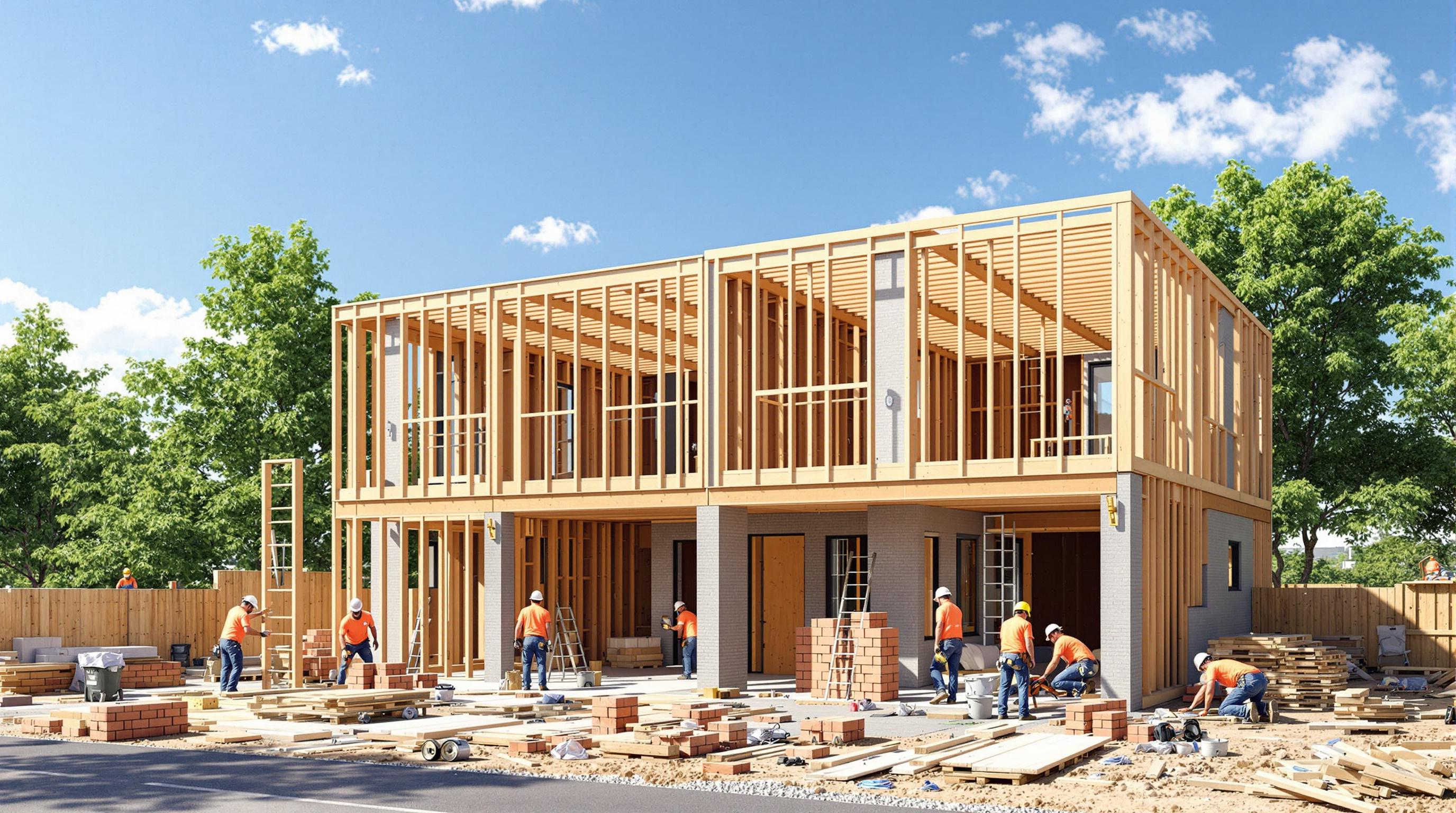Want to build a net-zero home in Nova Scotia? Here’s what you need to know:
Net-zero homes produce as much energy as they consume, thanks to efficient design and renewable energy systems. In Nova Scotia, this approach can save on energy costs, meet future building codes, and qualify for government incentives. For multi-unit rental properties, early planning is key to achieving energy balance and long-term savings.
Key Takeaways:
- Site and Design: Choose a location with good solar access, minimize heat loss with airtight construction, and optimize building orientation for natural light.
- Energy Systems: Use solar panels, heat pumps, and energy-efficient windows. Battery systems can store surplus energy for consistent power.
- Incentives: Nova Scotia and federal programs offer rebates and financing for energy-efficient construction, including CMHC’s MLI Select program for rental properties.
- Construction Method: Integrated design-build models and modular construction improve efficiency, reduce waste, and control costs.
Building a net-zero property ensures lower operating costs, higher rental appeal, and compliance with Nova Scotia’s 2050 emissions goals. With the right planning and resources, it’s a smart investment for property owners.
Net-Zero 101 - A guide to building your future-proofed dream home
Planning and Design for Net-Zero Multi-Unit Properties
Achieving net-zero energy performance in multi-unit properties requires meticulous planning and design. This approach not only promises long-term energy savings but also ensures competitive rental returns. The key lies in upfront, integrated planning that prioritizes energy efficiency from the start. Instead of treating it as an afterthought, net-zero design requires careful coordination of decisions around site selection, building orientation, and system integration. This avoids costly retrofits and ensures a seamless energy-efficient construction process.
Site Selection and Building Orientation
Selecting the right site plays a huge role in achieving net-zero energy goals. One of the most important factors is solar access. To maximize it, choose a location that avoids shading during peak sunlight hours.
Building orientation is just as crucial. Positioning the building’s longest side to face south can maximize solar gain, while an east-west layout ensures each unit benefits from natural light without overheating during the summer. Additionally, designing the roof to accommodate solar panels effectively is essential for energy production.
Wind protection is another factor that impacts energy performance. Strategic landscaping or natural windbreaks can reduce heat loss caused by wind exposure. It’s also important to consider utility connections early on, particularly the capacity for grid tie-ins and net metering. Consulting with your local utility provider during the planning stage can help identify any required service upgrades or adjustments. These foundational choices set the stage for an energy-efficient design.
Energy-Efficient Design Strategies
Energy efficiency starts with airtight construction. Continuous air barriers and precise sealing techniques are critical to minimizing energy loss.
High-performance insulation is another must-have. Continuous exterior insulation helps eliminate thermal bridges, while energy-efficient windows with the right coatings balance natural light with reduced heat loss.
Heat recovery ventilators (HRVs) can make a big difference too. These systems reclaim heat from outgoing air to pre-warm incoming fresh air, maintaining indoor comfort without excessive energy use.
The building’s shape also matters. A compact, straightforward design with fewer corners and complex shapes reduces the exterior surface area, minimizing heat loss and limiting potential thermal bridging.
Multi-Unit Design Considerations
Multi-unit buildings come with natural energy-saving advantages. Shared walls between units reduce overall heat loss compared to standalone structures, as less surface area is exposed to the outside.
When it comes to heating and cooling systems, you’ll need to decide between individual or centralized setups. Individual systems offer more control for each tenant, while centralized systems can sometimes be more efficient when serving multiple units at once.
Electrical systems should be designed to accommodate both unit-specific needs and building-wide renewable energy integration. Separate panels for each unit, combined with a main electrical service capable of handling solar arrays and battery storage, simplify energy management.
Lastly, thoughtful design choices can make the property more appealing to tenants. Well-planned layouts, efficient use of space, and modern features can increase rental income. Additionally, preparing for future needs - like pre-wiring for EV chargers or creating space for additional solar capacity - ensures the building can adapt to evolving energy technologies and tenant preferences. These forward-thinking decisions not only enhance energy systems but also boost the property’s overall appeal.
Energy Systems and Renewable Technology
Advanced energy systems and renewable technologies play a crucial role in achieving net-zero goals. By integrating systems that reduce energy consumption and generate clean power, properties can achieve a balance that benefits both the environment and the bottom line. The key lies in combining energy-efficient designs with renewable energy solutions, offering long-term savings while ensuring year-round comfort for tenants.
Renewable Energy Systems
Solar panels are an effective renewable energy solution for multi-unit properties in Nova Scotia. Through net metering programs, any excess energy produced can be fed back into the grid, helping to offset periods when solar production is lower. This not only reduces reliance on traditional power sources but also creates a more sustainable energy cycle.
Ground-source heat pumps are another excellent option, leveraging the earth’s constant underground temperatures to provide efficient heating and cooling. While the upfront cost can be higher, these systems often lead to substantial energy savings in the long run, making them a smart investment for property owners.
Battery systems complement renewable technologies by storing surplus energy, ensuring a steady and reliable power supply. Together, these renewable solutions pave the way for the integration of high-performance building systems.
High-Performance Building Systems
High-performance building systems work hand-in-hand with renewable energy sources to further cut energy demand and improve tenant comfort. For instance, cold-climate heat pumps are designed to handle Nova Scotia’s harsh winters efficiently, offering both heating and cooling capabilities. Similarly, energy-efficient windows - like triple-pane models - reduce heat loss, eliminate drafts, and maintain a stable indoor environment.
Smart controls add another layer of efficiency. Features like programmable thermostats, automated ventilation, and real-time energy monitoring systems allow properties to adjust energy use based on occupancy and weather. Advanced insulation techniques, such as continuous exterior insulation, help eliminate thermal bridges, reducing heating and cooling needs significantly.
Energy Management and Grid Integration
Effective energy management is the backbone of net-zero performance. Net metering allows properties to send extra solar energy back to the grid, essentially turning the grid into a large, virtual battery. Real-time energy monitoring systems provide valuable insights into energy consumption and production, enabling property managers to make proactive adjustments for better efficiency.
Smart load management further optimizes energy use by shifting nonessential tasks to times of peak renewable energy production. Additionally, planning for grid integration ensures the electrical system can handle both renewable energy input and the property’s energy demands. Some utilities even offer incentives for reducing energy use during peak hours, adding another layer of financial benefit.
sbb-itb-16b8a48
Nova Scotia Incentives and Financing Programs
Exploring incentives and financing options can make net-zero multi-unit construction in Nova Scotia much more achievable. The province offers programs aimed at energy-efficient builds, while federal initiatives focus on supporting carbon-neutral projects. These frameworks help developers access government rebates and appealing financing options.
Building Codes and Net-Zero Standards
Nova Scotia adheres to the National Building Code (NBC) 2020, which outlines energy efficiency requirements for new construction. To achieve net-zero performance, projects need to go beyond these minimum standards. This approach not only supports smart investment in rental properties but also aligns with anticipated updates to the code, which are expected to further emphasize net-zero goals.
Current building codes emphasize insulation, air sealing, and mechanical efficiency. However, net-zero projects take this a step further by incorporating advanced envelope designs and higher-grade insulation to minimize thermal bridging.
For larger multi-unit projects, the National Energy Code for Buildings provides additional guidelines to enhance energy performance. Net-zero properties typically achieve much lower energy use intensities compared to buildings that meet only the minimum code requirements.
Across Nova Scotia, building officials are becoming more familiar with net-zero construction techniques. Still, some municipalities may require additional documentation for innovative systems. Partnering with experienced builders who understand both the existing codes and advanced net-zero standards can simplify the permitting process and ensure compliance.
Government Rebates and Incentive Programs
Efficiency Nova Scotia offers rebates through its New Construction Program, which provides per-unit incentives for multi-unit buildings that meet specific energy performance benchmarks.
At the federal level, the Greener Homes Initiative helps fund renewable energy systems and energy storage solutions. Property owners can access rebates for solar panels, battery storage, and ground-source heat pumps, making these technologies more affordable.
The Canada Mortgage and Housing Corporation (CMHC) also supports energy-efficient construction through various financing programs. These initiatives help reduce borrowing costs and extend amortization periods, improving cash flow for property owners.
Municipal incentives differ across the province. For example, Halifax Regional Municipality may offer property tax reductions or other benefits for projects that exceed energy performance standards. Some municipalities even provide expedited permitting or reduced development fees for energy-efficient projects.
The Clean Growth Program, managed by the Atlantic Canada Opportunities Agency, offers grants and low-interest loans for larger multi-unit developments that adopt clean technologies. These funding options, combined with specialised financing, make net-zero construction more financially viable.
CMHC MLI Select and Construction Financing

CMHC MLI Select is a standout financing option for net-zero multi-unit construction in Nova Scotia. This program provides high loan coverage for energy-efficient rental properties, requiring a relatively small down payment and offering extended amortization periods to lower monthly carrying costs.
To qualify, properties must significantly exceed baseline energy performance standards. Net-zero developments are particularly well-suited to meet these criteria, making them strong candidates for the program. While upfront construction costs can be higher, the favourable financing terms often balance out these expenses.
MLI Select also includes affordability requirements, such as reserving a portion of units for lower-income households. This aligns with the goals of many net-zero multi-unit projects, which often cater to middle-income tenants.
The application process involves detailed energy modelling and third-party verification to confirm performance targets. Collaborating with builders familiar with CMHC requirements can make this process smoother. For instance, Helio Urban Development offers a CMHC MLI Select construction package - priced at $200,000 per unit - that includes all necessary documentation and verification to help property owners navigate the program efficiently.
While net-zero construction may require higher initial credit facilities due to increased investment, the long-term benefits are substantial. Reduced operating costs lead to strong cash flow and appealing returns for property owners. Unlike traditional construction loans, CMHC-backed financing requires much lower down payments. Securing financing commitments early in the development process is crucial, as energy-efficient projects often qualify for better interest rates and extended approval timelines when applications are submitted promptly. These financial advantages, paired with a comprehensive construction approach, ensure both energy efficiency and solid rental revenue.
Construction Approaches: Fixed Price vs. Cost-Plus Methods
Selecting the right construction method for your net-zero multi-unit property is key to managing costs and meeting deadlines.
Fixed-price construction offers a set total project cost before work begins, providing financial predictability. This approach often works well with integrated teams and modular construction techniques - methods that significantly cut material waste and reduce weather-related delays [1].
On the other hand, cost-plus construction charges for actual expenses plus a contractor's fee. While this method can offer flexibility, it comes with the risk of budget overruns and unexpected delays, making a unified delivery model even more critical.
Integrated vs. Fragmented Construction Delivery
Traditional construction often involves separate contracts with architects, engineers, and tradespeople. This fragmented setup can lead to coordination issues and a lack of accountability when problems arise.
"In today's volatile construction market, manufacturers can often lock in material prices and provide firm quotes. This reduces the all-too-common budget overruns that plague site-built projects." - Hutter Architects [1]
In contrast, an integrated design-build model brings architects, engineers, and construction teams together from the outset. This collaboration allows for seamless implementation of modular construction methods. Factory-controlled production not only boosts accuracy but also reduces material waste by up to 80% [1]. These efficiencies align perfectly with net-zero goals, cutting waste while ensuring performance. For instance, in Bellingham, Washington, builders completed a 1,055-square-foot net-zero home using an ICF foundation and SIPs for about $144 per square foot (excluding land), showcasing both cost control and reliable timelines [1].
Modular construction also shortens build times to as little as three months and minimizes weather-related disruptions. This method not only achieves net-zero standards but also ensures strong long-term returns.
Quality Control and Performance Testing
Integrated methods go hand-in-hand with rigorous quality control, which is essential for net-zero performance. Inspections at key stages - such as foundation work, envelope installation, and mechanical systems setup - help catch and correct issues early. Regular progress updates, including photo documentation, improve transparency and allow for timely adjustments.
After construction, energy performance testing ensures systems function as designed. Tools like blower door tests, thermal imaging, and comprehensive commissioning confirm that net-zero systems meet their targets. Additionally, the precision of modular, factory-controlled construction optimizes labour efficiency, a critical advantage in tight labour markets [1].
In Edmonton, Canada, Landmark Homes has shown how detailed quality control can make net-zero construction affordable. By using prefabrication and streamlined processes, they deliver homes that meet net-zero standards without the typical "green premium" associated with traditional methods [1].
For added peace of mind, integrated builders working under fixed-price contracts take responsibility for any corrections or delays, giving property owners confidence throughout the project.
Conclusion: Achieving Net-Zero Construction and Strong Returns
Building net-zero multi-unit properties in Nova Scotia offers a winning combination of environmental responsibility and steady financial returns. By using an integrated design-build model and fixed-price construction, you can keep costs predictable and projects on schedule. This streamlined approach avoids the common pitfalls of fragmented coordination between architects, engineers, and contractors, which often lead to budget overruns and delays.
Once your construction methods are in place, taking advantage of provincial incentives can further improve your financial outlook. Nova Scotia's rebate programs and CMHC MLI Select financing provide opportunities to stretch your capital, enabling you to develop more units while meeting net-zero performance standards.
Features like heat pumps, triple-pane windows, and advanced insulation not only lower operational costs but also make your properties more appealing to tenants. Energy-efficient systems can reduce utility bills, attract higher rents, and cut down on maintenance issues - benefits that directly enhance your bottom line.
Partnering with integrated construction teams that guarantee on-time delivery and performance is key to staying on budget and starting rent collection without delays. A builder who takes full accountability ensures you avoid costly overruns and keeps your investment on track. With careful planning and execution, a net-zero property becomes a reliable, high-performing asset that aligns with Nova Scotia's clean energy goals.
FAQs
What are the main advantages of building a net-zero multi-unit property in Nova Scotia?
Building a net-zero multi-unit property in Nova Scotia comes with plenty of advantages for property owners.
From a financial perspective, there are government energy rebates available that can help cut down on construction expenses. Plus, energy-efficient designs often lead to higher rental income and better overall returns. In fact, net-zero projects tend to be more profitable than standard builds, making them a smart investment for the long haul.
On the environmental side, these properties align with Nova Scotia’s goal of achieving carbon neutrality by 2050. By significantly cutting greenhouse gas emissions and running on renewable energy, net-zero buildings not only improve energy efficiency but also enhance the overall quality and durability of the structure.
With a combination of cost savings, stronger returns, and environmental advantages, net-zero construction presents a practical way for property owners to achieve both economic and sustainability goals.
What are the best ways to incorporate renewable energy systems, like solar panels and heat pumps, into a net-zero home in Nova Scotia?
To integrate renewable energy systems into a net-zero home, it’s all about combining smart design with clean energy solutions. Solar panels play a central role, turning sunlight into electricity to power your household. Meanwhile, heat pumps offer an efficient way to handle both heating and cooling, using far less energy than conventional systems.
For the best results, focus on making your home as airtight and well-insulated as possible - this keeps energy demand low. Adding smart energy management tools can help you fine-tune energy use even further. Plus, if you’re in Nova Scotia, check out local government incentives that can help reduce installation costs, making the move to net-zero living easier on your wallet.
What financial incentives and government programs can help build net-zero multi-unit properties in Nova Scotia?
Nova Scotia has several financial programs designed to encourage net-zero construction for multi-unit properties. One standout is the Affordable Rental Construction (ARC) pilot program, which offers funding to private and non-profit developers focused on building net-zero or net-zero-ready affordable housing units.
Another key resource is Efficiency Nova Scotia, which provides energy assessments, options for property upgrades, and guidance on integrating renewable energy into rental properties.
On a broader scale, the Canada Greener Homes Initiative supports energy-efficient projects with grants and interest-free loans. Locally, the Energize Bridgewater Program offers rebates and financing options to promote sustainable construction practices.
These initiatives are designed to make net-zero construction more attainable, addressing both environmental goals and the growing demand for affordable housing.



